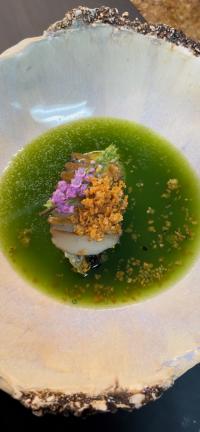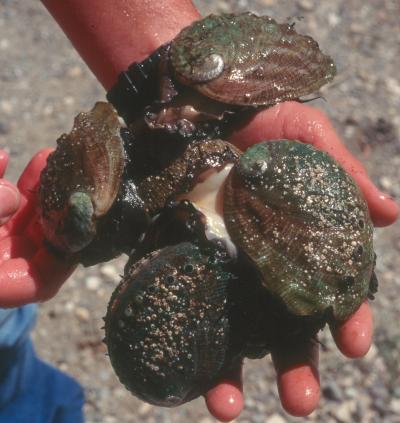Executive Chef Justin Cogley is known for his beautiful, sea-inspired tasting menus at the L’Auberge’s Aubergine Restaurant in Carmel. For 12 years straight, his nightly menu has included farm-raised red abalone that he sources from the nearby Monterey Abalone Company.
“We clean it, save the livers for the sauces and tenderize it 25 times with the constant tap of a small wooden mallet,” Cogley said.
Although the preparation can vary from there, the chef often slow cooks the shellfish in its own shucking liquid with a bit of dried seaweed, sometimes serving it in a shallow pool of bright green lettuce broth, a wink to the abalone’s kelp diet.
For many of his Californian guests, the abalone isn’t just another tasty course, it’s a dish chock-full of nostalgia for a time when its buttery, prominent presence could easily be found on dinner menus up and down the Golden State. But it’s not a childhood memory shared by the 44-year-old chef.
By the time Cogley was born, California’s voracious appetite for the state’s most iconic shellfish was abruptly coming to an end. Overfishing of wild abalone and the recovery of sea otter populations that also like to feast on the mollusk caused steep declines in the abalone population.

Abalone at risk
There was a time when California’s coastline teemed with millions of them: white, black, red, green, pink, pinto and flat abalone. They’re a species that have long been economically and culturally important to tribes, fishermen and residents.
We know from the earliest middens (shell-piles) that Native American tribes relied on abalone as far back as 12,000 years ago. California’s settlers also looked to abalone for food, trade and as a way to generate wealth. With Chinese and Japanese immigration came the culinary know-how that helped spur the state’s fishery, creating jobs and fueling demand.
But as the fishery declined, many wondered: Could wild populations be saved by releasing hatchery grown abalone, and could culinary demand for it help launch a brand-new aquaculture industry? Armed with the first of more than five decades of scientific funding from California Sea Grant, researchers were determined to help.
For pioneering researcher David L. Leighton, the challenge meant starting from scratch.
Beginning in 1971, he partnered with scientists from several universities while attempting to rear the larvae of five commercially important species of abalone. That meant understanding the influence of temperature and diet on abalone growth and more.
Later, researchers including Daniel Morse of UC Santa Barbara and Mia Tegner, UCSD Scripps Institution of Oceanography kept the work moving forward—discovering how abalone spawned and settled; and how to replicate the reproductive cycle in controlled tanks—work that helped kickstart California’s abalone aquaculture industry that numbered just over a dozen at it’s peak. Unfortunately, the horizon did not remain trouble-free.
Fighting a shell-dwelling pest
In the mid1990s, California Sea Grant Extension Specialist Carolynn Culver was a graduate student at UC Santa Barbara when the sabellid worm, a pest that had originated in South Africa, began infecting abalone farms throughout California.
“It’s fascinating for a little worm,” she said. “It gets underneath the mantle of the abalone and irritates the tissue which causes the abalone to secrete shell around it resulting in a home for the worm.”
The worm isn’t in the meat of the shellfish, but causes abnormal and brittle shell growth, stunting the abalone and making it difficult for it to reach market size. Because much of the then-fledgling abalone aquaculture industry relied on one another for seed abalone, the worm spread quickly among farms, research facilities and even aquariums.
“Eventually, we found it was not a native species and that’s when the research really switched,” Culver said.
Not all abalone farming at the time was done in land-based tanks. Many growers were raising abalone in the ocean, increasing concern that the sabellid worm would spread, threatening wild populations.
To get past the crisis, Culver worked closely with industry and resource agency members to develop management practices growers could adopt that would eliminate cross contamination between tanks. Clean nets. Clean tools. Clean hands. The change in farming practices worked.
By 1999, the pest was eradicated from every farm, research and aquarium facility in the state, but the celebration was short-lived.

A new threat and solution
Withering syndrome, a disease lethal to both farmed and wild abalone, had arrived. Triggered by a bacterial pathogen in the abalone’s gut, the disease causes the abalone’s foot to shrivel. It was a one-two punch for the state’s fledgling aquaculture industry.
“When withering syndrome hit, the growers were worried about even talking about it. They didn’t know if it was pollution or what,” said John Richards, a former California Sea Grant advisor. “Finally, a fella brought in a black abalone that had the withering foot syndrome, and I brought it to UC Davis to find out what it was.”
Once again, California Sea Grant funding was tapped to help researcher Carolyn Friedman develop an antibiotic therapy that helped protect farms from withering syndrome. The breakthrough in 2005 was key to the survival of the few remaining abalone farms in the state.
“California Sea Grant was relied on heavily to combat both the withering syndrome and sabellid worm,” says Jim Moore, the recently retired shellfish pathologist with the California Department of Fish and Wildlife. “They have been the mainstay of funding that’s allowed the industry to get past these issues.”
CA Sea Grant provides keys to survival
For Art Seavey, partner at Monterey Abalone Company, California Sea Grant’s work has been a lifeline for his own farm and the industry.
“Every farm and hatchery in the state was impacted by the sabellid worm. There wasn’t a single facility that wasn’t affected,” he said. “Sea Grant helped coordinate the whole California aquaculture industry in response to those two threats.”
Now one of just three remaining California growers, Seavey says culturing abalone is far more than just a labor of love. It’s about keeping the idea of abalone as a California food alive in people’s minds.
“We get so many people who show up in our shop to purchase abalone who then tell us their stories,” he said. “Stories about how a father or uncle taught them to dive for it. The ways they tenderize and cook it. Who they eat it with. How happy they are that they can still buy it. We hear story after story like that.
“The support we’ve received from California Sea Grant over the decades has been extremely important to the existence of our company,” Seavey said.
And, no doubt, a necessity for long-time Californians still looking for a taste of their childhoods.
About California Sea Grant
NOAA’s California Sea Grant College Program funds marine research, education and outreach throughout California. Headquartered at Scripps Institution of Oceanography at the University of California San Diego, California Sea Grant is one of 34 Sea Grant programs in the National Oceanic and Atmospheric Administration (NOAA), U.S. Department of Commerce.